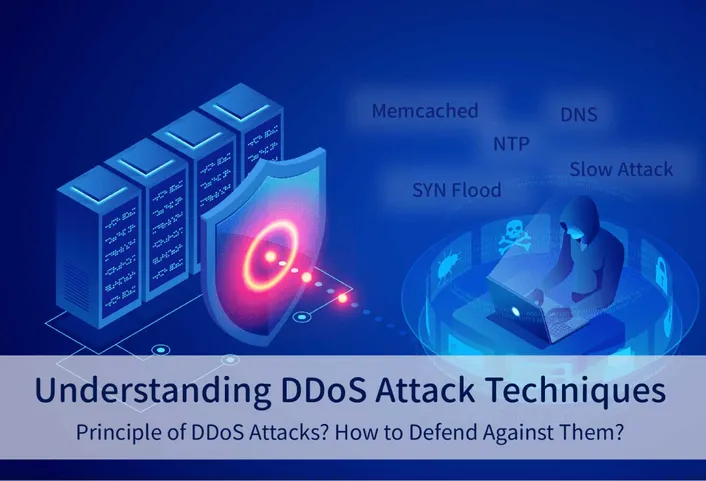What is DDoS? Understanding DDoS Attack Techniques and How to Defend Against Them!

When it comes to DDoS attacks, organizations of all sizes, regardless of their scale, may become targets of online assaults. As early as 2020, even AWS (Amazon Web Services) experienced a significant attack that they successfully thwarted! Therefore, regardless of your industry, all businesses should possess the capability to protect their websites from DDoS attacks, especially those with security vulnerabilities, as they face greater risks. In this article, we will delve into what DDoS is, explore the most commonly used attack techniques by hackers, and propose solutions for preventing these attacks. Let's together delve into this crucial topic of network security!
DDoS, What Is It?
DDoS, or Distributed Denial-of-Service, is a prevalent type of online threat. This form of cyberattack poses a significant risk to your business operations, online security, sales performance, and overall reputation. Attackers manipulate abnormal traffic behind the scenes, flooding the target website to disrupt network services. They achieve this by depleting the resources of applications, rendering the website and servers incapable of functioning properly, and, in some cases, even causing them to go offline directly.
Why Launch DDoS Attacks?
DDoS attacks target a wide range of victims, often focusing on well-known websites or financial service systems, including companies across various industries globally. Among these, the gaming industry, e-commerce, and telecommunications are particularly prone to being attacked, experiencing a significantly higher frequency of attacks compared to other sectors. As for why DDoS attacks are launched, common motives include hacker extortion, attacks from competitors, data theft, and purely malicious pranks.
Principle of DDoS Attacks? What Are the Attack Manifestations?
To better understand what DDoS (Distributed Denial-of-Service) is, you can think of it as an upgraded version of DoS (Denial of Service) attacks. In a DDoS attack, hackers typically distribute a large volume of service requests or network packets, causing the target system's host to experience network bandwidth overload or resource exhaustion. Often orchestrated by a series of bots or a zombie network, these attacks involve a flood of HTTP requests and traffic directed at specific websites or services, forcing web pages or game servers to cease functioning and rendering users unable to access them.
These denial-of-service attacks can persist for several hours, or even days. Whether it's individual or corporate devices, both can fall victim to such attacks! If you want to check whether your system has been subjected to a DDoS attack, here are some common signs to help you quickly identify DDoS attack symptoms:
- Unusually Slow Network Speed: If your network performance significantly slows down when opening files or visiting websites, it could be a sign of a DDoS attack.
- Suspicious Traffic from a Single IP Address or IP Range: A notable increase in traffic from a specific IP address or IP range, especially within a short period, may indicate an attack.
- Large Amounts of Traffic from Users with Similar Behavioral Characteristics: A sudden influx of traffic from users with similar geographic locations, device types, or the same web browser version could be the work of DDoS attackers.
- Sudden and Unexplainable Surge in Requests: A sudden surge in requests for a specific single page or endpoint, with no clear explanation for the increase, may be a sign of a DDoS attack.
- Strange Traffic Patterns: Unusual spikes in traffic during non-peak hours or the appearance of irregular patterns, such as regular spikes every 10 minutes, could indicate an ongoing attack.
Common Types of DDoS Attacks
DDoS attacks present diverse threats, encompassing various attack types, with "Bandwidth Consumption" and "Resource Consumption" being the most common and favored by hackers. Although the tactics for these two types of attacks differ, their goal is to disrupt businesses' ability to provide services. Below, we delve into these two primary DDoS attack methods to provide a comprehensive understanding of this network security challenge.
I. Bandwidth Consumption Type
Understanding Bandwidth Consumption, DDoS is particularly important, as it is one of the most common attack types! This attack floods the target server's bandwidth intentionally by sending a massive volume of invalid data requests, causing saturation and making it impossible for normal users to access, potentially leading to website crashes—a form of paralysis attack. The following are common attack methods for Bandwidth Consumption:
1. Memcached Amplification Attack
Hackers targeting businesses often choose to use Memcached for DDoS attacks because servers using Memcached services are typically commercially oriented, with broader service bandwidth. However, this scenario inadvertently provides an advantage to DDoS attackers. Attackers typically use UDP packets to transmit data, making packet forgery more convenient.
2. NTP Amplification Attack
NTP amplification attacks target vulnerabilities in NTP servers. Many securities brokerage firms in Taiwan have fallen victim to this type of DDoS attack, including notable cases at KGI Securities, Yuanta Securities, and Asia Securities. These attacks primarily focus on NTP, causing a sudden and substantial increase in website traffic.
3. DNS Amplification Attack
Attackers send a large number of UDP packets to the target host, disrupting the host's normal services. This type of attack is known as a DNS amplification attack because the size of the packets returned by the victimized DNS host is greater than the size of the packets sent by the attacker, resulting in an amplification effect during the attack. If the target host lacks adequate protective measures, the network environment becomes susceptible to attackers, potentially causing paralysis.
II. Resource Consumption Type
What is Resource Consumption DDoS? Unlike Bandwidth Consumption DDoS attacks, this type aims to continually engage the victim's server in repetitive and ineffective operations, depleting webpage resources and eventually rendering the server unable to respond to normal user requests or provide services. Common attack methods for Resource Consumption are divided into the following two attack modes:
1. SYN Flood Attack
SYN Flood is currently one of the most prevalent DDoS attack methods. It exploits flaws in the TCP protocol by sending a large number of forged TCP connection requests. As a result, the targeted resources, such as CPU or memory, are depleted, achieving the attacker's goal.
2. Slow Attack
Different from regular large-scale DDoS attacks, Slow Attacks leverage extremely slow HTTP or TCP traffic to obstruct web services. Its characteristics include being difficult to detect and requiring only one attacker's machine to successfully initiate the Slow Attack.
How Enterprises Can Defend Against DDoS Attacks?
DDoS attacks often result in significant losses for businesses, not only facing the risk of hefty ransom demands but also the potential loss of customer trust due to data breaches. Therefore, DDoS prevention becomes a challenge that every business must address, and a robust DDoS defense strategy can be implemented in four main directions:
I. Firewall
Firewalls are one of the fundamental protection tools in a system, primarily used to combat resource consumption DDoS attacks, such as SYN Flood attacks and application layer DDoS attacks. The role of a firewall is to identify attack packets within the traffic and isolate them, effectively reducing the threat of DDoS attacks.
II. Switches and Routers
Most switches and routers come with protection mechanisms like rate limiting and Access Control Lists (ACL). Switches, with their Traffic Shaping mechanism, are useful for preventing low-rate slow attacks and SYN Flood attacks. Routers can enable Ingress Filtering to prevent attacks like SYN Flood with forged IP addresses. When used together, they can detect and filter packets based on their source IP addresses.
III. Network Traffic Scrubbing
Network traffic scrubbing services can be categorized into two types: resident defense and dynamic defense. In resident defense, all enterprise traffic is directed to a scrubbing center for continuous analysis. In dynamic defense, traffic is not normally directed to the center but is redirected for analysis once an attack is detected. Most service providers can offer scrubbing and protection against attacks such as Memcached DDoS, NTP DDoS, and DNS amplification attacks.
IV. Intrusion Prevention System (IPS)
The full name of this defense system is Intrusion-Prevention Systems. It performs specific signature matching for abnormal traffic and, upon detection, blocks and provides protection. IPS is effective against DDoS attacks with different characteristics and specific communication protocols, such as SYN Flood and application layer DDoS attacks. It offers reliable protection against these types of attacks.
Conclusion
Today's DDoS attacks come in various types, quantities, and methodologies, making it challenging for businesses to rely solely on a single mechanism or system for comprehensive prevention. How can you effectively defend against DDoS attacks? Don't worry! CyberArk International provides a one-stop solution for major enterprises. Through Microud Unlimit Traffic Cloud, we focus on network security environments and system website construction, offering services essential for business development. These include ECS Security Group Strengthening (Virtual Firewall) with state detection packet filtering capabilities, effectively filtering all vulnerabilities. Additionally, DDoS WAF can protect applications, websites, and APIs, ensuring resilience against malicious traffic threats at both the network and application layers. If you have cloud hosting needs, feel free to contact us.






